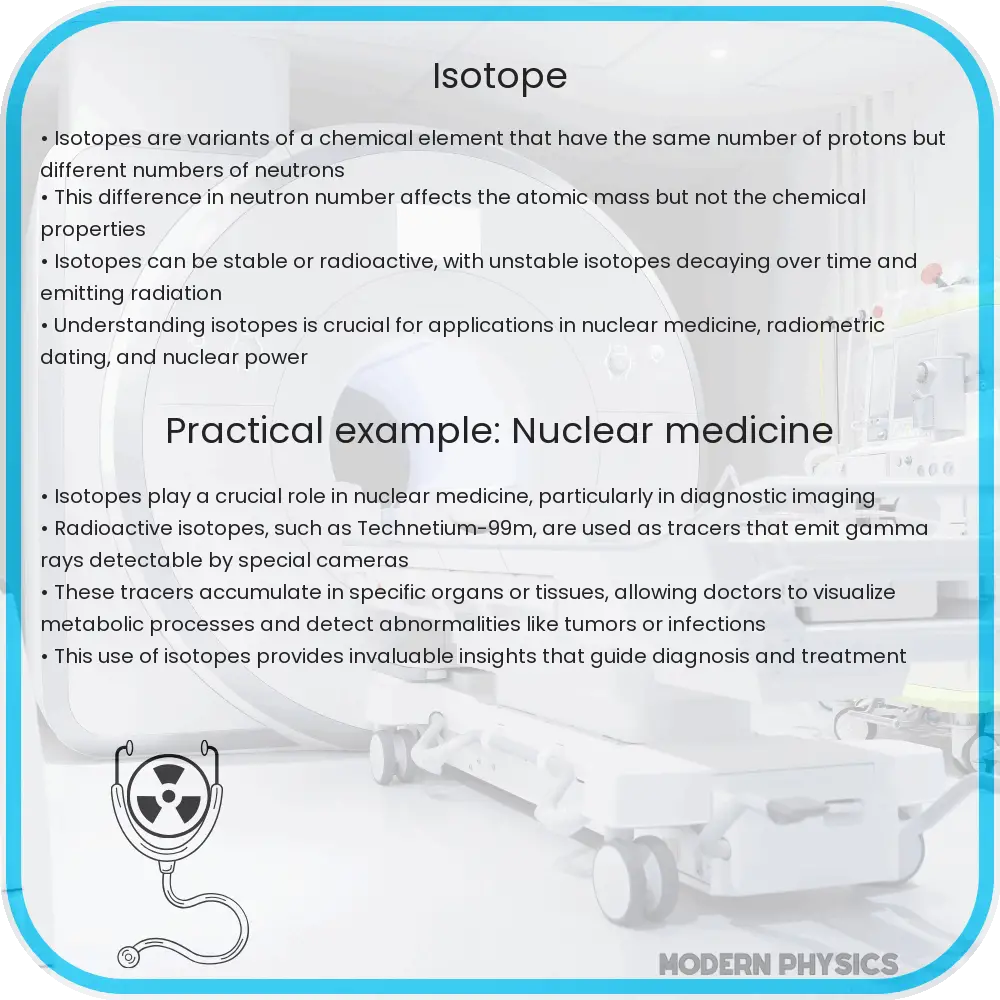Learn about isotopes, variations of elements with the same protons but different neutrons, used in science and technology.

Understanding Isotopes: Basics, Types, and Uses
Isotopes are variants of a particular chemical element that share the same number of protons but differ in the number of neutrons. This fundamental concept is crucial in various fields of science, including chemistry, physics, and medicine. In this article, we dive deep into the world of isotopes, exploring their types, uses, and how they differ from one another.
What are Isotopes?
Every atom is defined by its atomic number and mass number. The atomic number is the count of protons in the nucleus which determines the chemical element. However, the number of neutrons in an atom’s nucleus can vary. These variations are known as isotopes. Isotopes of a single element possess identical atomic numbers but different mass numbers, as the mass number is the sum of both protons and neutrons.
Types of Isotopes
- Stable Isotopes: These isotopes do not decay over time and remain constant. For example, Carbon-12, a stable isotope of carbon, consists of 6 protons and 6 neutrons.
- Radioactive Isotopes (or radioisotopes): These isotopes are unstable and can decay over time, emitting radiation in the process. An example is Carbon-14, which has 6 protons and 8 neutrons and is used in radiocarbon dating.
Key Differences Between Stable and Radioactive Isotopes
The primary difference between stable and radioactive isotopes lies in their stability. Stable isotopes do not change under normal conditions, while radioactive isotopes decay into other elements and emit radiation. This decay process is characterized by a specific parameter known as the “half-life,” which is the time required for half of the radioactive isotope sample to decay.
Applications of Isotopes
Isotopes are incredibly useful in various scientific and practical applications:
- Medical Imaging and Treatment: Radioactive isotopes are widely used in medicine. For example, Technetium-99m is used in millions of medical diagnostic procedures annually, helping to image the heart, lungs, kidneys, and bones.
- Archaeological Dating: Carbon-14 dating, a well-known application of isotopes, allows archaeologists to determine the age of ancient organic materials by measuring the decay of Carbon-14 into Nitrogen-14.
- Industrial Applications: Certain isotopes are used in industrial gauges to measure the thickness of materials and in the radioactive tracing techniques that help in mapping oil and gas deposits underground.
- Agricultural Research: Isotopes can be used to study the movement of nutrients in the soil and their uptake by plants, aiding in more effective fertilization and crop management strategies.
The versatility of isotopes makes them integral to advancements in science and technology. By understanding isotopes, their types, and applications, we gain valuable insights into both the atomic-scale phenomena and the large-scale processes of our world.
Environmental Monitoring
Isotopes also play a crucial role in environmental monitoring and management. The isotopic composition of substances such as water can reveal information about sources and the history of water bodies. For instance, oxygen isotopes in ice cores are used by climatologists to study ancient climates and make predictions about future climate changes. Similarly, in pollution studies, isotopes can help trace the source of pollutants in the environment, facilitating more targeted clean-up efforts.
Educational Implications
In the educational sector, isotopes serve as a fundamental topic within chemistry and physics curricula. Teaching about isotopes assists students in understanding complex concepts such as atomic structure, atomic mass, and radioactivity. Educators use isotopes to illustrate the practical applications of foundational scientific theories in daily life and industrial processes, enhancing student engagement and comprehension.
Safety Considerations
While isotopes are invaluable in many sectors, handling particularly radioactive isotopes requires strict safety protocols to protect against undue exposure to radiation. Safety measures include using proper containment, limiting exposure time, and adhering to regulatory guidelines specified by health and safety authorities. These precautions ensure the safe use of radioactive isotopes in various applications.
Conclusion
Isotopes, whether stable or radioactive, are more than just scientific curiosities; they are tools that enhance our understanding of the world and aid in technological advancements across a myriad of fields. From medical diagnostics and treatment to environmental monitoring and archaeological dating, the applications of isotopes are vast and critical to modern science and industry. By delving into the details of isotopes, we enrich our knowledge of chemistry and physics, gaining a deeper appreciation for the intricate and dynamic nature of matter. As we continue exploring isotopes, it is essential to handle them with care, especially the radioactive types, ensuring their benefits are harnessed responsibly. Thus, isotopes not only challenge our scientific acumen but also remind us of our responsibilities towards safe and ethical scientific practices.
